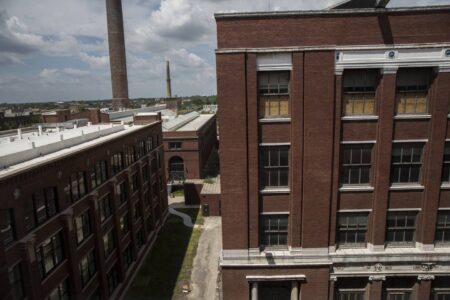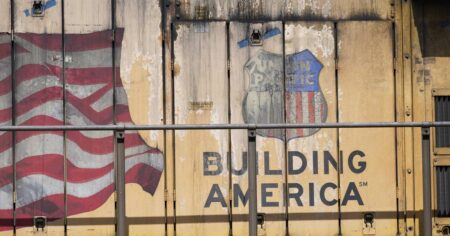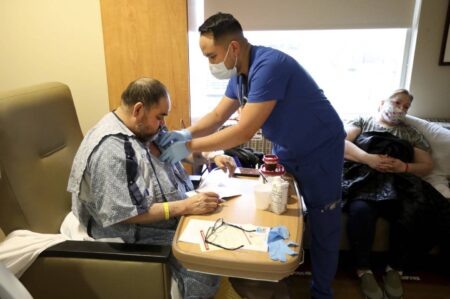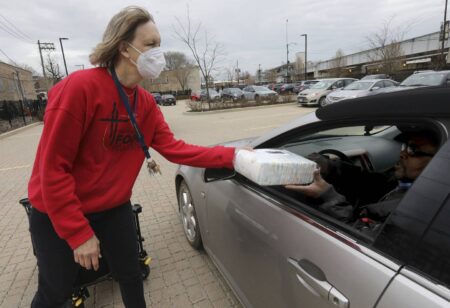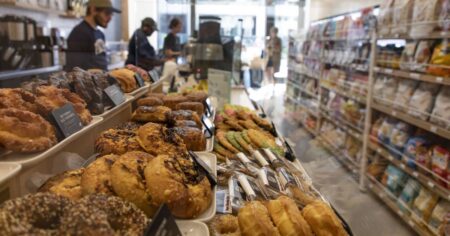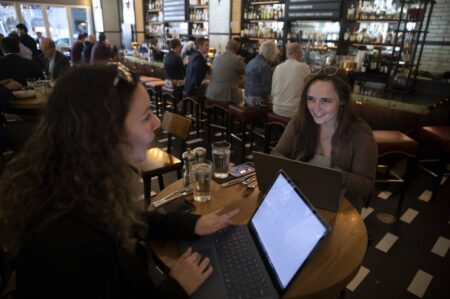Subscribe to Updates
Get the latest creative news from FooBar about art, design and business.
Browsing: Business
Mayor Lori Lightfoot’s administration is set to launch several development projects in the West Side neighborhood of North Lawndale, but a coalition of local community groups and developers said Monday the area’s economic troubles have deep roots, and though the mayor’s initiative is welcome, it won’t be enough.“We love the mayor’s INVEST South/West program and think it’s great, so we thank the mayor for that,” said Richard Townsell, executive director of the Lawndale Christian Development Corp. “But since the riots in 1968, North Lawndale has been on a downward trend in terms of population, and one thing is not going to solve it.”AdvertisementTownsell’s group, along with partners North Lawndale Community Coordinating Council, North Lawndale Employment Network and Sinai Community Institute, unveiled a report at the City Club of Chicago from the Great Cities Institute at the University of Illinois at Chicago, detailing both the challenges facing the West Side community of nearly 35,000, and how to reverse decades of disinvestment.North Lawndale was once the home of Sears, which ran its national mail order business out of a 55-acre complex that stretched across the neighborhood, a beehive of activity that provided thousands of jobs. Sears headed downtown in the 1970s, and other manufacturing giants such as International Harvester and Western Electric also left. Unemployment soared in the ensuing decades, leading to population decline and a deteriorated housing stock. Smaller local businesses also shut their doors, leaving behind a neighborhood with several thousand vacant lots and little economic activity.AdvertisementThe historic Sears, Roebuck & Co. Printing Building in Homan Square, North Lawndale has been transformed into 181 affordable housing units by nonprofit developer Mercy Housing Lakefront, June 14, 2017. (Zbigniew Bzdak / Chicago Tribune)“My mother escaped sharecropping by moving up from Tennessee in the ’50s to North Lawndale, where she went to work,” Townsell said. “But when you take a business, you lose not only that business, but also the businesses that fed off it, the coffee shops, diners and car washes.”North Lawndale now sits in the middle of a food desert, a region with no sizable grocery stores, forcing residents to spend their money outside the community, according to Teresa Córdova, director of the Great Cities Institute. That’s not just a matter of convenience. Unless those dollars stay in North Lawndale, commercial spaces will stay empty, cutting out an important source of jobs.“The most basic rule of economic development is you have to have dollars circulating in your community,” she said. “North Lawndale residents have to leave the neighborhood for almost everything because almost every category of goods and services is not available.”North Lawndale residents spend $124 million of their wages outside the community each year, researchers found. Furthermore, businesses did add about 3,000 jobs to the neighborhood between 2010 and 2018, but most went to nonresidents. That’s partly because more than 20% of the jobs require a college degree, a credential held by just 12.7% of North Lawndale residents. Overall, white workers hold more than half of neighborhood jobs, while making up only 2.3% of North Lawndale residents. The mismatches help explain why nearly half of local households are forced to pay 50% or more of their incomes toward rent, leaving little or nothing for savings.“What is needed right now is to plug the leaks,” Córdova said.LCDC and its community partners planned for years to bring in affordable housing, new retail and other economic development, Townsell said, but having such a detailed analysis will help set priorities and ensure future development benefits residents.The Soul Food Lounge is on the ground floor of the Dr. King Legacy Apartments in Chicago, April 25, 2022. (Jose M. Osorio / Chicago Tribune)“We knew money was leaking out of the community, but we didn’t know quite how much,” Townsell said. “And it was sobering to see in the richest country in the world how much people were spending of their hard-earned incomes just to find housing.”Lightfoot kicked off her INVEST South/West initiative in 2019, targeting 10 communities on the South and West sides. According to the mayor’s office, in the first two years it mobilized more than $1 billion of private and public funds for a series of mixed-use developments, including Lawndale Redefined, a $31.4 million project in North Lawndale. A joint venture of GRE Ventures, Imagine Group and 548 Development, it will replace a vacant plot on Ogden Avenue with dozens of apartments and town homes, retail and restaurant spaces, as well as a community center. In addition, earlier this year, the city selected 548 Development and Related Midwest to develop at 4300 West Roosevelt Road the $38.4 million Lawndale Innovation Center, a collection of solar-powered industrial buildings and community centers. The vacant 20.8-acre site was once an illegal dumping ground made infamous in the 1990s by the federal Operation Silver Shovel investigation, which led to the convictions of several aldermen.AdvertisementTownsell said the community would also like to see the city appoint an ombudsman for North Lawndale, someone who could cut through any red tape that might delay new development projects. The Great Cities report also shows the neighborhood needs a construction loan program for new, affordable single-family homes, and a flexible emergency fund to help those seeking employment pay for child care or work supplies.“Even though the unemployment rate in North Lawndale is three times higher than the city of Chicago, that’s not a reflection of people’s desire to work,” said Brenda Palms Barber, president and CEO of North Lawndale Employment Network.Above all, to improve the quality of life, the neighborhood needs grocery stores, Townsell said.“We found out during the pandemic how important health was, and we need people to have access to healthy, affordable options for produce.”brogal@chicagotribune.com
Elon Musk reached an agreement to buy Twitter for roughly $44 billion on Monday, promising a more lenient touch to policing content on the platform where he promotes his interests, attacks critics and opines on social and economic issues to more than 83 million followers.The outspoken Tesla CEO, who is also the world’s wealthiest person, has said he wanted to own and privatize Twitter because he thinks it’s not living up to its potential as a platform for free speech.AdvertisementMusk said in a joint statement with Twitter that he wants to make the service “better than ever” with new features, such as getting rid of automated “spam bots” and making its algorithms open to the public to increase trust.“Free speech is the bedrock of a functioning democracy, and Twitter is the digital town square where matters vital to the future of humanity are debated,” Musk said, adding hearts, stars and rocket emojis in a tweet that highlighted the statement.AdvertisementA more hands-off approach to content moderation has many people concerned the platform will become more of a haven for disinformation and hate speech, something it has worked hard on in recent years to mitigate.The deal was cemented roughly two weeks after the billionaire first revealed a 9 percent stake in the platform. Musk said last week that he had lined up $46.5 billion in financing to buy Twitter, putting pressure on the company’s board to negotiate a deal.Twitter said the transaction was unanimously approved by its board of directors and is expected to close in 2022.Shares of Twitter Inc. rose 6% Monday to $52 per share. On April 14, Musk announced an offer to buy the social media platform for $54.20 per share. While the stock is up sharply since Musk made his offer, it is well below the high of $77 per share it reached in February 2021.Musk has described himself as a “free-speech absolutist” but is also known for blocking or disparaging other Twitter users who question or disagree with him.In recent weeks, he has voiced a number of proposed changes for the company, from relaxing its content restrictions — such as the rules that suspended former President Donald Trump’s account — to ridding the platform of fake and automated accounts, and shifting away from its advertising-based revenue model. Musk believes he can increase revenue through subscriptions that give paying customers a better experience, perhaps even an ad-free version of Twitter.Asked during a recent TED talk if there are any limits to his notion of “free speech,” Musk said Twitter or any forum is “obviously bound by the laws of the country that it operates in. So obviously there are some limitations on free speech in the US, and, of course, Twitter would have to abide by those rules.”Beyond that, though, he said he’d be “very reluctant” to delete things and in general be cautious about permanent bans.AdvertisementIt won’t be perfect, Musk added, “but I think we want it to really have the perception and reality that speech is as free as reasonably possible.”After the deal was announced, the NAACP released a statement that urged Musk not to allow former President Trump, the 45th president, back onto the platform.“Disinformation, misinformation and hate speech have NO PLACE on Twitter,” the civil rights organization said in a statement. “Do not allow 45 to return to the platform. Do not allow Twitter to become a petri dish for hate speech, or falsehoods that subvert our democracy.”Efforts to “deregulate” Twitter could thwart the company’s current commitment to making the platform as safe as possible for all users, said Brooke Erin Duffy, professor of communication at Cornell University and an expert on social media. ““Marginalized communities of users are especially vulnerable to the forms of hate and harassment that so often circulate in unregulated online spaces,” she said.Some users said Monday that they were planning to quit the platform if Musk took it over. To which he responded on Twitter: “I hope that even my worst critics remain on Twitter, because that is what free speech means.”AdvertisementMusk has battled with the Securities and Exchange Commission on multiple occasions, as he has used Twitter to taunt the regulators.The SEC has been investigating Musk’s August 2018 tweets in which he asserted that he’d secured funding to take Tesla private for $420 a share, though he had not. Musk is fighting an SEC subpoena in the case in federal court. More recently, Musk appeared to have violated SEC rules by failing to disclose at the point he reached a 5% stake in Twitter, waiting until he had more than 9%.Noteworthy as they are, the SEC matters have no bearing on Musk’s fitness to buy a company, according to St. John’s University business professor Anthony Sabino, making it unlikely that they would represent roadblocks to the takeover.With initial concerns of its own about the deal, Twitter had enacted an anti-takeover measure known as a poison pill that could make a takeover attempt prohibitively expensive. But the board decided to negotiate after Musk updated his proposal last week to show he had secured financing, according to The Wall Street Journal.While Twitter’s user base of more than 200 million remains much smaller than those of rivals such as Facebook and TikTok, the service is popular with celebrities, world leaders, journalists and intellectuals. Musk himself is a prolific tweeter with a following that rivals several pop stars in the ranks of the most popular accounts.Last week, he said in documents filed with U.S. securities regulators that the money would come from Morgan Stanley and other banks, some of it secured by his huge stake in Tesla.AdvertisementMusk is the world’s wealthiest person, according to Forbes, with a nearly $279 billion fortune. But much of his money is tied up in Tesla stock — he owns about 17% of the electric car company, according to FactSet, which is valued at more than $1 trillion — and SpaceX, his privately held space company. It’s unclear how much cash Musk has.Musk began making his fortune in 1999 when he sold Zip2, an online mapping and business directory, to Compaq for $307 million. He used his share to create what would become PayPal, an internet service that bypassed banks and allowed consumers to pay businesses directly. It was sold to eBay for $1.5 billion in 2002.That same year, Musk founded Space Exploration Technologies, or SpaceX, after finding that cost constraints were limiting NASA’s interplanetary travel. The company eventually developed cost-effective reusable rockets.In 2004, Musk was courted to invest in Tesla, then a startup trying to build an electric car. Eventually he became CEO and led the company to astronomical success as the world’s most valuable automaker and largest seller of electric vehicles.Musk’s pledge to make Twitter a haven for free speech could dim the appeal of Donald Trump’s troubled Truth Social app, which the former president has touted as a competitor to Twitter that would cater to conservatives. Truth Social is part of Trump’s new media company, which has agreed to be taken public by Digital World Acquisition Corp. Shares of DWAC dropped 16.2% Monday and are down 46% since Musk revealed his stake in Twitter.Krisher reported from Detroit. O’Brien reported from Providence, R.I. AP Business Writer Kelvin Chan reported from London.
All the major railroads now plan to offer their employees up to $600 a month in advance of raises they expect to pay once the current two-year-old national contract talks are eventually settled.But a coalition of unions that represents more than 105,000 railroad workers said Monday they’ll refuse the payments partly because workers would be on the hook to repay some of the money if the eventual raises aren’t big enough to cover the payments. The unions want the National Carriers’ Conference Committee that represents more than 30 railroads to negotiate a contract instead.Advertisement“This latest proposal, somewhere between a loan and a payday advance, is just further evidence that the NCCC has no intentions of reaching a voluntary settlement any time soon,” the unions said in a statement. “You don’t offer temporary proposals if you plan to offer a complete contract settlement.”The group that represents the railroads didn’t immediately respond to the unions Monday.AdvertisementThe railroads all announced their payment proposal Friday a few days after CSX announced it had offered these payments to its unions. Executives at CSX and Union Pacific said when they announced their earnings last week that an overall contract with the unions is likely still some time away.Both Union Pacific and CSX reported a 22% jump in their earnings as the railroads were able to increase rates and collect more fuel surcharges even as they struggled to clear up congestion on their rail networks that has delayed deliveries to customers.The contract talks remain mired in mediation while the railroads pursue unpopular proposals to cut rail crews from two people down to one in certain circumstances. The unions also don’t want to make major concessions in workplace rules after seeing nearly one-third of all railroad jobs eliminated over the past six years as the major freight railroads have overhauled their operations.The unions have also complained that BNSF and Union Pacific have imposed tough new attendance rules in the past two years without negotiating them that make it difficult for workers to take any days off.
It may be some time before people can walk through Illinois hospitals, doctors’ offices and nursing homes barefaced, despite mask mandates dropping on buses, planes and trains last week.On Tuesday, Gov. J.B. Pritzker amended the state’s mask mandate so that it no longer applies to trains and buses after a federal judge in Florida voided the national mask mandate for transportation and major airlines pulled back their masking requirements. Masking requirements in most stores and schools ended earlier this year.AdvertisementHealth care settings, however, remain some of the last places in Illinois where everyone must continue to cover their mouths and noses. The state still requires masks in hospitals, nursing homes, dialysis centers, physician offices, dental offices and outpatient care centers, in line with guidance from the Centers for Disease Control and Prevention, according to the state health department.Registered nurse Paolo Salvallon wears his face mask as he checks in on patient Ismael Sanchez at Loyola University Medical Center in Maywood on April 22, 2022. (Antonio Perez / Chicago Tribune)Illinois is not considering lifting its mandate for hospitals and other health care settings “at the moment,” said Jordan Abudayyeh, a spokeswoman for Pritzker, in an email Thursday. That’s despite hospitals in some states, including Texas and Iowa, beginning to roll back their mask requirements.AdvertisementLocal hospital leaders say Illinois’ continued mask mandate for health care settings is just fine with them.“We would mandate it anyway,” said Dr. Richard Freeman, regional chief clinical officer for Loyola Medicine, which has three hospitals in the Chicago area. “Anybody in the hospital, all our personnel are still masked, visitors still have to be masked. That is not going to change in the foreseeable future.”That’s partly because many patients in the hospital are immunocompromised, meaning they’re more at risk if they catch COVID-19. Also, many people who go to hospitals have undiagnosed conditions that sometimes turn out to be COVID-19, he said.Sinai Chicago, which has two acute care Chicago hospitals, will continue to follow guidance from the CDC and state health department, said Dr. Russell Fiorella, chief medical officer and vice president of medical affairs.Sinai had zero admitted patients with COVID-19 as of Thursday. But the masks add an extra layer of protection, Fiorella said.“As it stands now, I think it’s a comfort to our patients, it’s a comfort to our caregivers,” Fiorella said. “It provides safety. We’re comfortable as a system with that.”Patient care technician Eimann Joseph Mago checks vitals and orders on a computer at Loyola University Medical Center in Maywood on April 22, 2022. (Antonio Perez / Chicago Tribune)Esperanza Health Centers, which has community health centers on the West and Southwest sides of the city, also has no problem continuing to follow the state’s mandate, given that patients who don’t know they have COVID-19 may sometimes visit Esperanza’s clinics, said Dr. Ana Cortez, medical department administrator.“I think it’s really important to keep protecting the patients and the staff,” Cortez said.AdvertisementVisitors at Northwestern Memorial Hospital in Chicago on Friday had mixed opinions about continued mask mandates in hospitals.Camille Baxter, 62, of Oak Park, said continuing to require masks at hospitals makes sense to her.“The health care system has been so impacted by the pandemic, and you never know who’s been exposed to what,” said Baxter, who accompanied her husband to the hospital for treatment. She said she’s continued to wear masks in other indoor, crowded settings as well.“We’re all uncomfortable. I’d love not to wear it,” she said. But, “to me, if it protects me and others it’s a small thing I can do.”Tom Streible, however, said masks should no longer be mandated in hospitals. Streible, 66, of Romeoville, was at the hospital Friday while his fiancee underwent surgery.He said he’s already received three shots of the vaccine, so he doesn’t feel that he needs a mask, though he wore one in the hospital Friday in compliance with the rules. People who are immunocompromised or at high risk of getting seriously ill from COVID-19 may still want to wear masks, he said, but not everyone should have to.Advertisement“It should be your own preference,” he said.
A poorly worded inscription on a plaque at the base of a monument outside the Old Will County Courthouse implies credit for the monolithic 1969 concrete structure should go to architect J.C. Cochrane, designer of Illinois Capitol and other notable buildings.He designed the Lake County Courthouse in Crown Point, Indiana, as well, so one doesn’t have to travel all the way to Springfield to discover his busy, classical style doesn’t really fit the imposing flat stone walls of the Joliet edifice.AdvertisementAlso, Cochrane died in 1887, a major impediment to designing postmodern architecture.In the plaque writer’s defense, Cochrane had designed an earlier, much more ornate courthouse for Will County in 1884, where the county’s legal business was handled for 80 years before it was unceremoniously demolished to pave the way for the modern structure now known as the old courthouse.AdvertisementA century-old postcard shows the former Will County Courthouse, which was demolished in the late 1960s. (Daily Southtown file)Architect Otto Stark, known for designing the office building at 55 W. Wacker Drive in Chicago, is credited with the design of the 1969 courthouse, which won architecture awards at the time.Stark’s design is appropriately stark, in a style called Brutalist, not because it’s brutal, but because the French term for raw concrete is “beton brut,” and the old courthouse features plenty of that material. It was a popular style in the turbulent late ‘60s, especially for government buildings. Much like in Joliet, Lake County’s ornate 1878 courthouse in Waukegan was torn down in 1967 and replaced with a Brutalist-style successor.A half-century later, Stark’s courthouse in Joliet is facing the same fate as its predecessor. Will County officials seem intent on demolishing it now that they have a brand new steel and glass courthouse with an award-winning design across the street.That imminent danger helped put the Old Will County Courthouse on the 2022 list of Most Endangered Historic Places in Illinois, announced last week by the preservation advocacy group Landmarks Illinois. It joins the Eugene S. Pike House in Dan Ryan Woods on Chicago’s South Side, the Century & Consumers Buildings on South State Street in the Chicago’s Loop, Rockford’s Elks Lodge No. 64 and Gillson Park in Wilmette.It’s the shortest list in the 25 years Landmarks Illinois has been compiling it, which is encouraging to Bonnie McDonald, the organization’s executive director. She said other resources the organization offers have helped make a dent in the number of historic structures at risk due to redevelopment or “demolition by neglect.”“Our programs around technical assistance and grant funding and resources are growing,” she said. “Because those are growing, the number of endangered properties are shrinking.”Since issuing the first Most Endangered list in 1995, the group has featured about 300 sites, McDonald said, with about a 50% success rate.“We think of that as a success because these properties come to us in imminent danger,” she said. “The wrecking ball is coming. They’re deteriorating, and often times it’s seen as a last resort. To have had success with over half of them, we feel like it’s a triumph.”AdvertisementConstruction of a new courthouse in Joliet is shown in 2018, looking west from the Old Will County Courthouse. Now that the new courthouse has been completed, county officials want to demolish the old structure. (Ted Slowik / Daily Southtown)One of their most proud triumphs isn’t far from the courthouse. The Joliet Penitentiary made the list in 2002, just months after its last inmates were transferred to other state prisons. In a Tribune story about that year’s list, Landmarks Illinois officials said the prison would be one of the group’s most difficult challenges, requiring “creative thinking to come up with an adaptable use plan for that structure.”Now called the Old Joliet Prison Historic Site and managed by the Joliet Area Historical Museum, the site is still being stabilized with the help of millions in grant funds while also offering tours and hosting concerts, an annual haunted house and other events.That success was largely the result of a group of active local supporters, McGrath said, a crucial element to getting on the Most Endangered list.“We require local support,” she said, “an organization we can work with to ensure success.“If we have a nomination from a single person, or we find there isn’t a local support base, we will work with whoever we can, but we won’t put it on the Most Endangered list.”While lots of preservation efforts receive grants, resources and other support from Landmarks Illinois, the Most Endangered list is a way to rally public support around an effort as well as generate ideas for showcase projects. Including properties that don’t have a local support, or ones where “the wrecking ball is truly right down the road and (demolition) is a week away” would be counterproductive, McGrath said.Advertisement“The purpose of the list is to identify opportunities around these places and address challenges, and find solutions that can be used across the state,” she said. “These are models for other communities.“We want it to be meaningful and to make a real difference. These are examples of larger issues around the state like public ownership and lack of public funding, owners who are using demolition by neglect, and policy issues. That’s really the purpose of this list.”Sometimes, it doesn’t work out. Another Brutalist building, the Prentice Women’s Hospital in Chicago, appeared on the Most Endangered list for four consecutive years starting in 2009 before demolition began in 2013.But McDonald prefers to focus on the success stories, such as Chicago’s James Thompson Center, another regular that came off the list this year after four years now that a sale and renovation plan seemingly have spared it.People ride the elevator inside the James R. Thompson Center in Chicago in December. The recent sale of the building is considered a preservation win by Landmarks Illinois. (Armando L. Sanchez / Chicago Tribune)The Thompson Center also is encouraging because it involves an architectural style that’s just now coming around to being considered historic.“Not everyone sees postmodernism as historic and significant,” McDonald said. “How can something built in my lifetime be historic?Advertisement“This is really a story about how places gain significance for different generations. There’s a large group of people who see Brutalism and postmodernism as beautiful and significant. They tend to be younger people, under 40. It takes about 60 years for an architectural style to start to have a constituency of support.”There’s no doubt that being easy on the eyes can help a preservation effort along. The Eugene S. Pike House in Chicago’s North Beverly neighborhood is a stately old home built in 1894 by a prosperous developer whose estate was purchased by the Forest Preserve District of Cook County in 1921, later becoming Dan Ryan Woods. According to its Landmarks listing, the district planned to use the house as a superintendent’s headquarters and it eventually became the “Watchman’s Residence” in the 1960s.Daily SouthtownTwice-weeklyNews updates from the south suburbs delivered every Monday and WednesdayEmpty for years, the house has had active preservation support from the Beverly community, but it needs extensive repairs and a Forest Preserve District effort a few years ago didn’t generate any reuse ideas.McDonald said district officials are open to saving the structure and working with the community on a renewed effort to find another suitable use for the Pike House.That kind of partnership isn’t evident with the Old Will County Courthouse, where government officials seem intent on demolition while a group called the Courthouse Preservation Partnership is hoping to stave off its doom.McDonald said Landmarks Illinois still hopes to have “a constructive dialogue” and an opportunity to suggest reuse ideas for the old courthouse. But until then, adding the Brutalist structure to this year’s list is a way “to continue to bring that dialogue to the public,” she said.AdvertisementWhile it may not fit the profile of most historic structures, the Brutalist courthouse in Joliet has another very important quality that makes its preservation paramount, McDonald said — the countless people who have interacted with it over its five decades.“It tells the story of our community,” she said. “It’s part of the story of the people who live here.”Landmarks is a weekly column by Paul Eisenberg exploring the people, places and things that have left an indelible mark on the Southland. He can be reached at peisenberg@tribpub.com.
On a blustery afternoon in Lawndale, Beverly Harris waited in line outside Harmony Community Church for her turn to select from bags of apples and cartons of eggs, romaine lettuce and puff pastry from the food pantry in the church’s basement.Though she had never needed to get food at a pantry before, Harris, of Lawndale started coming about two months ago. Now, she visits the pantry most Wednesdays. The cost of everything is high. Every week, Harris said, it seems like the line outside the church gets longer and longer.Advertisement“Everybody needs help that I know of,” she said. Harris always leaves the pantry with enough food, and when she has more than enough, she shares with other people who need it, she said.Harris is among a growing number of people who have turned to food pantries in recent months as grocery prices skyrocket amid rising inflation. Food pantries across the city said they are seeing increased demand as dollars don’t stretch as far at the supermarket and people feel the pinch on the price of everything from household goods to gas.AdvertisementDiane Carioscio, the food pantry’s director, said visits to the pantry started increasing toward the end of February, and the pantry is now serving about 25% more people than is typical. Carioscio attributes the increase to the rising cost of food, as well as the end of some government aid programs that were available earlier in the COVID-19 pandemic.Diane Carioscio, director of the food pantry at Harmony Community Church, helps hand out diapers as people line up in their vehicles to get food and supplies at the pantry in the North Lawndale neighborhood on April 20, 2022. (Antonio Perez / Chicago Tribune)“We are also in a food desert,” she said, meaning residents need to travel farther than they do in other neighborhoods to get to a grocery store. That means the price of gas, which has also risen precipitously, creates another barrier to food access.Rosemarie Spears walked to the church Wednesday from her home nearby; gas prices are too high for her to drive, she said.“My car is parked and not moving at all,” she said. “I have two feet.”Spears said she’d been coming to the pantry for about a year, after she lost her job as a preschool teacher on the South Side. Spears used to receive unemployment, although that aid has since been cut off, she said. She had a baby girl six months ago and was able to get on food stamps recently.Spears said she was considering starting a garden to grow her own produce, as are other people she knows. “They’re talking about, well, if we grow our fruits and vegetables, then we’ll be good,” she said. “But what about the bread, and the beans and the rice?”AdvertisementGrocery and supermarket prices were 8.6% higher this February than in February 2021, according to the U.S. Department of Agriculture. Prices are expected to keep rising: the agency predicts grocery prices will increase between 3% and 4% this year, with the extent of inflation varying from product to product. Fresh fruit prices are expected to increase between 5% and 6% percent, with dairy prices expected to increase between 4% and 5% and fats and oils between 6% and 7%. The price of poultry, which could also be affected by an outbreak of avian influenza, is expected to increase by 6 to 7%.Volunteer Jackie Kareb, left, gives out food as dozens line up at the food pantry at Harmony Community Church in the North Lawndale neighborhood on April 20, 2022. (Antonio Perez / Chicago Tribune)At the same time, many government aid programs that helped families get through the beginning of the pandemic have expired. Sophie Milam, vice president of public policy and advocacy for the Greater Chicago Food Depository, noted the monthly payments some families received as part of the expansion to the child tax credit ended last year.AdvertisementFederal nutrition programs such as SNAP, Milam said, are adjusted for inflation only once a year. That means people who are dealing with surging food prices right now will not see their aid adjusted until October. Some help is available; in Chicago, families will be able to apply for a $500-per-month pilot cash assistance program starting Monday. An analysis from Northwestern University evaluating food insecurity in the Chicago metro area in late January and early February found more than 16% of households struggling with food insecurity. That percentage was highest among Black and Latino households, with 29% and 24% experiencing food insecurity, respectively, compared with 11% of white households. Families with kids were also more likely to struggle with access to food, the report found.Demand is up at food pantries across Cook County, said Maurice Cousin, director of food access capacity for the Greater Chicago Food Depository. The depository provides food to roughly 400 pantries, soup kitchens and shelters in Cook County. The food depository has provided food to pantries for free during the pandemic, and plans to do so for the upcoming fiscal year “and the foreseeable future,” Cousin said. A number of food pantry directors credited the program, at least in part, with their ability to keep high-quality food in stock.Pastor Sandra Gillespie, who runs a food pantry at the Chosen Tabernacle church in Englewood, said she’s started to see demand surge over the last five or six months, particularly among seniors.“I am literally talking to seniors who have to make a decision: am I going to buy my medicine or am I going to buy some food?” Gillespie said. “You’re getting $16 a month in food stamps, that’s not taking you very far with these surging prices.”People in their vehicles drive up to receive free food, given out by volunteers at the food pantry at Harmony Community Church in Chicago’s north Lawndale neighborhood, April 20, 2022. (Antonio Perez / Chicago Tribune)The pantry doesn’t need to ration the food they give out, at least not yet, Gillespie said. “If my numbers continue to rise again, I see that on the horizon,” she said.AdvertisementLakeview Pantry, which operates in Lakeview and Humboldt Park as well as online, saw monthly visits increase over 18% in March than in January, according to spokesperson Greg Trotter. During the same period, the organization saw demand from households with children increase more than 25%.“A lot of folks are just really struggling with the prices at the grocery store,” said Kellie O’Connell, Lakeview Pantry’s CEO. “When they go in, their dollar doesn’t stretch as far as it used to. So they’re leaving the grocery store with less food for their families, for themselves, and then turning to a food pantry to supplement the groceries that they need for the week or for the month.”The Pilsen Food Pantry is serving 300 to 360 people each week, said executive director Evelyn Figueroa. “It has just not stopped,” she said. That’s more people than the pantry was serving in March 2020, she said, though the pantry was relatively new at the time and more people are aware of its services now.Most food pantry directors said demand was not close to reaching the heights it soared to at the beginning of the pandemic, when some people flocked to pantries for fear of food shortages. And despite supply chain problems, pantries generally aren’t having trouble keeping enough food on the shelves or serving everyone who shows up, although they’ve had to remain flexible when certain items are hard to get or their dollar doesn’t go as far as it used to.Cousin said the surge in egg prices, for instance, meant the food depository had to switch to buying medium eggs instead of large ones in order to source the same amount of product.Advertisement“We have to buy less, or there’s certain things we can’t buy,” Figueora said.“We all hate having days where there are carrots for the first 50 people,” she said. “We’d like there to be carrots for all the people.”As the world gets back to normal, Cousin said, he wants people to understand that the communities hardest hit during the pandemic because of a lack of investment will be slow to recover.“In no way is this pandemic or the effects of it in the food insecurity space over,” Cousin said. “Those most hardest hit will be on the road to recovery for years to come.”tasoglin@chicagotribune.com
Chicago Public Schools CEO Pedro Martinez and his wife, Berenice, paid $690,000 for a four-bedroom house on the Near West Side in October.A Chicago native and a former chief financial officer for CPS, Martinez in September was appointed CEO of CPS by Mayor Lori Lightfoot, and his appointment was confirmed by the Chicago Board of Education. Immediately prior, he had been superintendent of the public school system in San Antonio, Texas, for six years.AdvertisementOn the West Side, Martinez and his wife bought a house in the Illinois Medical District. Built in 1991, the house has 3 ½ bathrooms, a fireplace in the living room, hardwood floors, a terrace overlooking the backyard, a lower level rec room, a second-floor owner’s suite with two walk-in closets, a covered outdoor living room and a top floor with two bedrooms and a large skyline-view terrace.The couple bought the house for less than the $728,000 than the previous owner had paid for it in 2007. Those owners first listed the house in July for $750,000, and cut their asking price later that month to $715,000 before they struck a deal Aug. 3 to sell the home to Pedro and Berenice Martinez. That Aug. 3 real estate contract was more than a month before Lightfoot publicly announced that she had chosen him as CPS’ CEO.AdvertisementPaz Martinez of Realty 123, who represented the couple, said she could not comment on her clients or even on their identities. However, she told Elite Street that “the property is in a very affluent neighborhood with a high volume of top-tier professionals.”“The property itself is tastefully designed with functionality, aesthetics that are pleasing to the eye and a modern interface with a flair of Chicago classic structural design,” she said.The house had an $18,192 property tax bill in the 2020 tax year.Goldsborough is a freelance writer.Join our Chicago Dream Homes Facebook group for more luxury listings and real estate news.
The wait is nearly over for 1.6 million Illinois Facebook users who filed claims in a landmark $650 million biometric privacy settlement.Their $397 checks should be in the mail beginning May 9, according to Chicago attorney Jay Edelson, who brought the lawsuit against Facebook seven years ago.Advertisement“Not only did we demonstrate that privacy cases can put real money back into the pockets of the class, we also showed that, when it comes to securing biometric privacy, the wind is at our collective backs,” Edelson said Friday.The payouts follow a ruling last month by the U.S. Court of Appeals for the 9th Circuit, which upheld the February 2021 class-action settlement over Facebook’s alleged violations of Illinois’ biometric privacy law. Two Illinois class members, Dawn Frankfother and Cathy Flanagan, who objected to the awarding of $97.5 million in attorneys’ fees agreed they “will not take any further action in this matter,” freeing up the distribution, according to an April 11 court filing.AdvertisementThe settlement class included about 7 million Facebook users in Illinois for whom the social network created and stored a face template after June 7, 2011. To qualify, Facebook users had to live in the state for at least six months over the previous nine years. More than one in five eligible Illinois Facebook users filed a claim by the November 2020 deadline.The claim form included name, address and preferred payment method. The claims administrator plans to begin mailing checks May 9, Edelson said. Electronic payments will go out in mid-May, and if any transfers are unsuccessful, a check will be issued to the claimant after 30 days.Class members who successfully filed online received an email confirmation upon submission. Most people who got a notice and submitted a claim were approved, Edelson said.Estimates of the payouts to class members have ranged between $350 and $400 during the lengthy settlement process. The final tally after expenses and fees is expected to come in at $397 for each class member, subject to final accounting.In April 2015, Edelson filed the lawsuit in Cook County Circuit Court on behalf of plaintiff Carlo Licata, alleging the social media giant’s use of facial tagging features without consent was not allowed under Illinois privacy law. The case was moved to Chicago federal court and then California federal court, where it attained class-action status.“When we started this case seven years ago, we knew we were in for an enormous fight,” Edelson said. “The ability to collect biometric information was at the core of Facebook’s business and they are one of the most heavily resourced companies in the history of the planet.”In November, Facebook announced it would shut down its facial recognition system amid “growing concerns” over the widespread use of the technology. As a result, Facebook said it planned to delete more than a billion facial recognition templates it had stored, putting an end to the feature that automatically recognized if people’s faces appear in memories, photos or videos.The Illinois Biometric Information Privacy Act, which was passed in 2008, is considered the strictest in the U.S. and requires companies to get permission before using technologies such as facial recognition and fingerprint scans to identify customers.Advertisementrchannick@chicagotribune.com
Disheveled journalists may no longer haunt the halls of the historic Tribune Tower, but a new Foxtrot market just opened at The Shops at Tribune Tower.The upscale cafe and corner store concept is based in Chicago. The 13th location in the city opened on Wednesday, April 20. It’s tiny, just two aisles wide, but with a soaring double-height storefront nearly directly under the landmark Chicago Tribune sign on the south side of the building.AdvertisementThe market is the first business open to the public in the historic tower. After deep reconstruction, the building is now filled with luxury residences and private amenities, like an indoor lap pool, instead of cluttered journalists desks.The Museum of Ice Cream was the first retail tenant announced, but it’s not yet open, but signage is up next door to Foxtrot.AdvertisementIt’s not a substitute for the Whole Foods just east, but rather a beautiful alternative to the Walgreens food in the Wrigley Building across the street. You can order colorful coffees, including a seasonal pink ombre cherry blossom latte, or breakfast tacos before noon. Or grab and go anytime The Chicago Farm Salad, seasonal and locally sourced, now with Mick Klug Farm asparagus and a Green Goddess dressing. You’re a Cookie founder and pastry chef Angela Diaz supplies vegan chocolate chip cookies from her wholesale bakery in the Avondale neighborhood.A small outdoor patio faces Pioneer Court for a secretive oasis just steps off the Magnificent Mile. Nearly all of the shade trees have been cleared for the replanted public plaza though.Foxtrot also dropped Wilco collaboration snacks and merch at a pop-up Yankee Hotel Foxtrot Market at its Old Town shop on Tuesday, open until May 1. The company plans to open two more locations in Chicago this year, at Willis Tower in May and Wrigleyville by early summer.Foxtrot Tribune Tower, 429 N. Michigan Ave., 312-496-3050, foxtrotco.comBig screen or home stream, takeout or dine-in, Tribune writers are here to steer you toward your next great experience. Sign up for your free weekly Eat. Watch. Do. newsletter here.
Chicago’s downtown almost looks normal some days, especially during the middle of the week when office workers pack themselves onto trains and the streets bustle with pedestrians. But downtown restaurant owners say they see something different when tallying weekly sales.Even the busiest lunch hours rarely hit pre-pandemic levels, and Mondays and Fridays are even worse.Advertisement“We’re questioning whether it even makes sense to be open on these days,” said Scott Weiner, co-owner of Fifty/50 Restaurant Group, which operates more than a dozen establishments across Chicago, including West Town Bakery and 90th Meridian, both on LaSalle Street in the financial district.And with many downtown firms planning to bring back their employees for just two or three days a week, restaurants could permanently lose several days of lunchtime business. That would be another heavy blow to an industry buffeted for two years by shutdowns, rising food prices and labor shortages, perhaps putting off real recovery for years.AdvertisementIt’s not just a problem for restaurant owners. The health of the local restaurant scene will play a key role in determining the vibrancy of downtown as it emerges from the pandemic.Downtown Chicago provides a greater variety of food options than any suburb or city neighborhood, from places to grab a quick sandwich to pricey establishments where businesses entertain out-of-town clients. Like Millennium Park or the lakefront, restaurants make downtown appealing. But if the industry continues to suffer, restaurant owners may decide it’s not worth it to reopen the many locations closed during the pandemic. Some say landlords may eventually have to agree to lower rental payments if they want to keep the restaurant scene healthy.On Wednesdays, hungry theatergoers attending afternoon matinees crowd into The Dearborn, a 225-seat restaurant at 145 N. Dearborn St., according to proprietor Clodagh Lawless. But it’s a different story on other days.“Wednesdays are just a delight,” she said. “Everything about Wednesday is perfect, but our Friday lunch is now very quiet, and that’s a problem, because we had a business model when we signed a lease which relied on a five-day workweek from our business clientele.”Two patrons at The Dearborn sit in the bar area of the restaurant in Chicago’s Loop during the lunch hour. With many downtown firms planning to bring back their employees for just two or three days a week, restaurants could permanently lose several days of lunchtime business. (Erin Hooley / Chicago Tribune)“The Loop is still in dire straits,” Weiner said. “We need the city and the people who call the shots at big companies to get people back to the office.”Weiner estimates lunchtime business is down between 60% and 70% on Mondays and Fridays, and on the other weekdays it’s down about 20%.The lingering uncertainty helps make it difficult to justify reopening Fifty/50 Restaurant Group’s Steadfast at The Gray, a Central Loop restaurant at 120 West Monroe St., in the same building as the Kimpton Gray Hotel. It was shuttered during the pandemic as business travel dried up and hotel occupancy plunged.Average hotel occupancy in downtown Chicago was 59% for the week ending April 9, according to hospitality data firm STR. It was 89.1% for the comparable week in April 2019.Advertisement“We’re not in any hurry to reopen Steadfast,” Weiner said.Lawless, who runs The Dearborn in partnership with her sister Amy Lawless, said they’ve survived the two years of turmoil brought on by COVID-19, and are determined to meet whatever challenges remain. She learned the business while growing up in Ireland from her parents, who ran restaurants and a small hotel, and switching careers isn’t an option.“It’s in our blood,” she said. “We know nothing else, but the restaurant industry, which I adore, right now is a bleak landscape.”People eat lunch at The Dearborn downtown on April 21, 2022. (Erin Hooley / Chicago Tribune)The pandemic squeeze may hit restaurants, which typically have small profit margins, harder than other businesses, according to Sam Toia, president and CEO of the Illinois Restaurant Association, an industry lobbying group.“Between 95 and 97 cents of every dollar goes toward labor costs, produce costs and fixed costs, Toia said. “And that’s in the good times.”Some downtown landlords have been willing to cut deals with restaurants during the crisis, allowing them to pay reduced rent while business was slow, he added.AdvertisementWeiner said if hybrid work schedules remain in place and restaurants can’t generate the revenue they once did, he’s optimistic landlords will negotiate the deals needed to keep these key businesses afloat, perhaps including lower rental rates.“The smart landlords are going to figure out ways to keep the restaurants in their buildings open, because if they don’t, they could lose their (office) tenants,” Weiner said.It’s not just upscale restaurants feeling the pinch. Fast-food operators have also noticed slowdowns.“Pre-pandemic Mondays and Fridays were softer days for us, averaging slightly lower than our Tuesday-Thursday business,” Potbelly Sandwich Shop COO Adam Noyes told the Tribune in a statement. “That gap has become a bit more pronounced in 2022, likely due to the hybrid office policies.”“We believe that these market condition pressures should definitely be considered by landlords to ensure that shops are able to be profitable,” he added. “We have found a number of landlords to be accommodating in supporting us through this recovery.”Michael Klein, managing principal of Glenstar, which owns the Chicago Board of Trade Building downtown, home of Ceres Café, said he agreed that if downtown businesses stick with short workweeks long term, restaurants will suffer. But he also cautions that the recovery is in its early stages, and office workers may still flood back downtown in the coming months.Advertisement“If we get to the point where 50% of the people are coming back to work, others may start to feel that they’re missing out on something, perhaps not getting that plum assignment,” Klein said.It’s difficult to measure in real time exactly how many downtown workers have returned. According to Kastle Systems, a security firm that tracks office entries, office occupancy in the Chicago metro area stood at 37.8% the week of April 13, the same as the week before, but the company doesn’t provide a separate breakout for the central business district.Klein added that tourists have returned in greater numbers than office workers, so restaurants near tourist-heavy areas like Michigan Avenue or Willis Tower should recover faster.“If you’re across from the Art Institute and go into Chick-fil-A, it may already feel normal because it’s filled up at lunchtime, but two or three blocks away in the Central Loop, restaurants are much quieter,” Klein said. “So, when people do come back, there are going to be discussions about what restaurant rents should be, but they’re going to be block by block, location by location decisions.”Weiner said he believes the old real estate adage, “location, location, location,” will be even more important to the downtown restaurant sector. Even though Fifty/50 Restaurant Group is keeping Steadfast closed for now, it’s already confident enough in the Chicago market to launch later this year one of its biggest projects yet, a two-story restaurant in Willis Tower called Kindling.Starting this fall, the 16,000-square-foot location’s chef will serve diners food cooked in a wood-fire rotisserie oven. Weiner said he expects many of the customers will be out-of-towners.Advertisement“Willis Tower is one of the top tourist destinations in Illinois, let alone Chicago, so it’s a totally different business model,” he said.Some Loop restaurants have advantages that should keep business humming no matter what happens.Gina Capitanini’s family has owned Italian Village Restaurants since 1927, a brand name that keeps customers returning to the landmark The Village at 71 W. Monroe St. Like The Dearborn, it also draws big crowds of theatergoers. Unlike most of their competitors, the family owns the property, thereby avoiding the astronomically high rents of downtown.“It’s a lot better than it was six months ago, so we’re surviving and even doing better than I expected at this point,” Capitanini said.A person walks by The Village restaurant on Chicago’s West Monroe Street on April 18, 2022. (Raquel Zaldivar / Chicago Tribune)The week before Easter was particularly rewarding.“I probably had two or three of the best days that I’ve had in the past two years,” she said. “I probably need more new employees than I need new customers.”AdvertisementBut the pandemic did force Capitanini to close both La Cantina and Vivere, the two other restaurants in the building. She currently has no plans to reopen either.Toia said more restaurants could go under even as more employees return to their workplaces unless Congress replenishes the Restaurant Revitalization Fund. The fund’s $28.6 billion in initial funding ran out last summer as thousands of restaurants nationwide rushed to secure relief.The House of Representatives approved this month $42 billion in grants for food service businesses, but according to an April 21 report in Roll Call, an aid package in the Senate faces headwinds after attracting little Republican support.About 177,000 restaurants were approved for grants through the Restaurant Revitalization Fund in 2021 but did not receive any funds, according to the National Restaurant Association.Gerardo Castillo, left, speaks to customer Jerry Boruch at The Village, one of Italian Village Restaurants’ three restaurants, on April 18, 2022. Boruch has been a regular customer since the beginning of the pandemic and dines at Italian Village Restaurants when he is downtown for business. (Raquel Zaldivar / Chicago Tribune)The Dearborn was one of the unlucky ones, Lawless said. She and her sister spent the past two years without help, paying rent and enduring several shutdowns, as well as the rising costs for food and labor.“In January, when omicron began surging, it was desolate downtown,” Lawless said. “I mean, it was literally tumbleweeds. So, our choice was, do we open for January and February and lose a ton of money, or stay closed and lose a ton of money? We chose to open so we could keep our team together.”AdvertisementIf Congress does replenish the relief fund, Lawless said The Dearborn could use the money to stock up on supplies and avoid any future supply chain disruptions, pay staff more, or perhaps give the restaurant’s interior a face-lift.No matter what happens with that legislation, Lawless said she sees hopeful signs. A full slate of conventions has returned to McCormick Place for 2022, and even though attendance so far is still significantly lower than 2019, groups attending these events are already making reservations weeks in advance.“Before this, our margins were tight, and now it’s even tougher,” she said. “But there’s definitely light at the end of the tunnel, the only question is, how long is this tunnel?”




